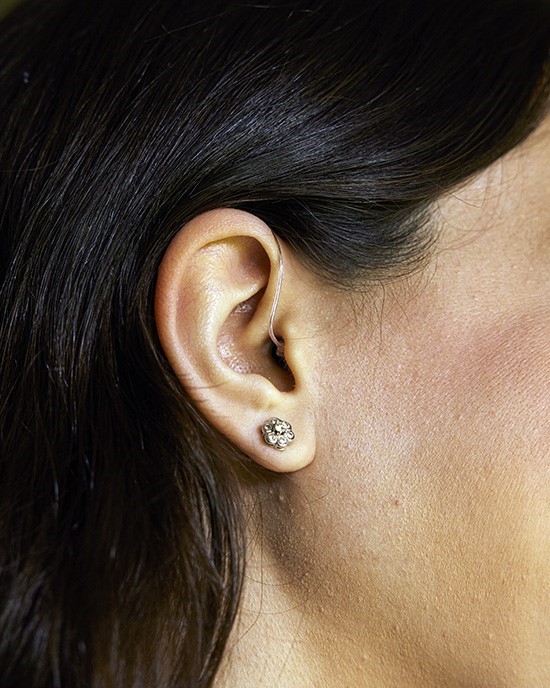Ayla Wing’s middle school students do not always know what
to make of their 26-year-old teacher’s hearing aids. The most common response
she hears: “Oh, my grandma has them, too.”
اضافة اعلان
But grandma’s hearing aids were never like this:
Bluetooth-enabled and connected to her phone, they allow Wing to toggle with
one touch between custom settings. She can shut out the world during a
screeching subway ride, hear her friends in noisy bars during a night out and
even understand her students better by switching to “mumbly kids”.
A raft of new hearing aids has hit the market in recent
years, offering greater appeal to a generation of young adults that some
experts say is both developing hearing problems earlier in life and — perhaps
paradoxically — becoming more comfortable with an expensive piece of technology
pumping sound into their ears.
Some of the new models, including Wing’s, are made by
traditional prescription brands, which usually require a visit to a specialist.
But the Food and Drug Administration opened up the market last year when it
allowed the sale of hearing aids over the counter. In response, brand names
including Sony and Jabra began releasing products, adding to the new wave of
designs and features that appeal to young consumers.
More people who are close to 20–25 age group might need the
equivalent of expensive AirPods, experts say. By the time they turn 30, about
one-fifth of Americans today have had their hearing damaged by noise, the
Centers for Disease Control and Prevention recently estimated. This number adds
to the substantial population of young people with hearing loss tied to
genetics or medical conditions.
The exact number of young adults who need or use hearing
aids is difficult to pinpoint, but both device manufacturers and medical
experts say that population is growing. The leading prescription aid
manufacturer, Phonak, says the number of Americans between ages 22 and 54 who
have been fitted with the company’s hearing aids increased by 14 percent more
than the increase for users of all other ages between 2017 and 2021.
“Anecdotally, we have seen more young people over the past
decade pursuing hearing protection. This seems to be much more mainstream,
which is great,” said Dr. Catherine V. Palmer, director of Audiology and
Hearing Aids at the University of Pittsburgh Medical Center and Children’s
Hospital.
Experts say there are several reasons that hearing aids are
closing the generation gap. Attitudes have changed as technology has advanced,
leading more young people to be willing to give them a try. And a growing
number of 20-somethings may need them as they navigate an increasingly
noise-soaked world; more than 1 billion young people worldwide risk
noise-induced hearing loss, according to the World Health Organization.
But there are still significant barriers: Hearing aids are
expensive — especially for people who lack good medical insurance — with most
costing $1,000 or more.
 A modern digital
hearing aid that goes in the ear canal, at the Kenneth Berger Hearing Aid
Museum at Kent State University in Kent, Ohio on April 27, 2023.
A modern digital
hearing aid that goes in the ear canal, at the Kenneth Berger Hearing Aid
Museum at Kent State University in Kent, Ohio on April 27, 2023.
While the emergence of over-the-counter hearing aids has
provided new options, it has also made diving into the market more complicated.
There are dozens of brands to choose from, ranging from small, in-ear pods to
those that use long metallic arcs around the ear. Most new models have
Bluetooth streaming capacities. And some of the over-the-counter options can
even be ordered online with free shipping.
Blake Cadwell created Soundly, a website that allows users
to compare hearing aid brands and prices, after trying to navigate the complex
market himself.
“When I started the process, the main thing I experienced
was it’s difficult to know where to start and how to start, just figuring out
which way was up,” said Cadwell, 32, who lives in Los Angeles.
Even getting a diagnosis for hearing loss can be hard.
People who are concerned about their hearing might start at an ear, nose, and
throat specialist, and many are referred to audiologists or hearing clinics,
where they face a mix of hearing tests, physical exams, or imaging.
Juliann Zhou, a 22-year-old international student at New
York University, was motivated to get her ears checked after being disturbed by
an intense ringing, which was diagnosed as tinnitus from moderate hearing loss.
Still, she has not been sold on hearing aids. An audiologist in the US
recommended them, but her parents and their family doctor in China told her
they were “only for old people.”
“I just don’t know if it’s necessary,” she said.
Zhou said she “probably listened to music too loud,” causing
her hearing issues. That’s an increasingly common concern, according to the
Hearing Loss Association, which has called noise-induced hearing loss a growing
public health crisis.
Although long-term tracking data is not available, the
association estimates that 12.5 percent of Americans between ages 6 and 19 have
hearing loss as a result of listening to loud music, particularly through
earbuds at unsafe volumes.
For those who need them, the new wave of over-the-counter
aids can be more affordable than many prescription models. That makes them a
good first choice for more young people, said Zina Jawadi, 26, who has used
hearing aids since she was 4 and attends medical school at the University of
California, Los Angeles.
“This is one of the biggest things I’ve seen in a really
long time in this space,” she said.
Wing, the middle school teacher, said she decided to buy her
new hearing aids just months before she would turn 26 and lose access to her
parents’ health insurance plan. Otherwise, the $4,000 prescription hearing aids
would have been unaffordable, she said.
Read more Health
Jordan News







